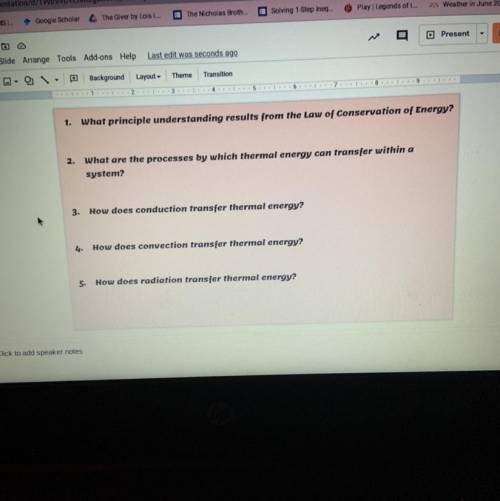
Physics, 10.03.2021 04:30 mariahgriego1125
1. What principle understanding results from the Law of Conservation of Energy?
2.What are the processes by which thermal energy can transfer within a
system?
3. How does conduction transfer thermal energy?
4. How does convection transfer thermal energy?
5. How does radiation transfer thermal energy?


Answers: 1


Another question on Physics

Physics, 21.06.2019 21:30
One day, after pulling down your window shade, you notice that sunlight is passing through a pinhole in the shade and making a small patch of light on the far wall. you see that the patch of light seems to be a circular diffraction pattern. it appears that the central maximum is about 1 cm across and you estimate that the distance from the window shade to the wall is about 3 m. what is (a) the average wavelength of sunlight? (b) the diameter of the pinhole?
Answers: 3

Physics, 21.06.2019 23:20
Acharge of 8.4x10^-4 c moves at an angle of 35 degrees to a magnetic field that has a field strength of 6.7x10^-3 t. if the magnetic force is 3.5 x10 ^-2 n, how fast is the charge moving?
Answers: 1

Physics, 22.06.2019 01:00
Need asap ! what is the relationship between atmospheric pressure and the density of gas particles in an area of increasing pressure? (2 points) as air pressure in an area increases, the density of the gas particles in that area decreases. as air pressure in an area increases, the density of the gas particles in that area increases. as air pressure in an area increases, the density of the gas particles in that area remains constant. as air pressure in an area increases, the density of the gas particles in that area increases and decreases in an alternating pattern. 3. which of the following correctly describes a way in which earth's atmosphere interacts with the geosphere? (2 points) it contains gases that living organisms breathe. it contains gases that trap incoming solar radiation. it provides a medium for cycles that provide nutrients to living organisms. it provides a medium for water to move between earth's surface and the air. 4. which of the following is considered a drawback to using wind energy as a source of power? (2 points) wind energy is nonrenewable. wind energy produces large amounts of air pollution. 5. a meteorologist predicts that the weather in a region will soon change from clear skies to probable thunderstorms. prior to making this prediction, what did the meteorologist most likely observe on a barometer? (2 points) the barometer fell slightly. the barometer fell substantially. the barometer rose slightly. the barometer rose substantially. 6. which of the following do meteorologists not typically use weather balloons to record? (2 points) atmospheric pressure cloud types humidity temperature 7. during which step in the can crush lab did water vapor force air from the can? (2 points) the can was filled nearly to the top with water. the can was placed on the hot stove top burner for several minutes. the can was removed from the hot stove top burner. the can was placed upside-down in the water-filled pan.
Answers: 2

Physics, 22.06.2019 06:30
How much force was applied to an object if was moved 2 meters and the work done on the object was 8 joules? a. 0.25 n b. 4 n c. 6 n d. 16 n
Answers: 1
You know the right answer?
1. What principle understanding results from the Law of Conservation of Energy?
2.What are the proc...
Questions


Geography, 30.04.2021 23:30


Mathematics, 30.04.2021 23:30


Social Studies, 30.04.2021 23:30

Mathematics, 30.04.2021 23:30

Biology, 30.04.2021 23:30

Mathematics, 30.04.2021 23:30

History, 30.04.2021 23:30



English, 30.04.2021 23:30

Mathematics, 30.04.2021 23:30


English, 30.04.2021 23:30



Computers and Technology, 30.04.2021 23:30

Social Studies, 30.04.2021 23:30



